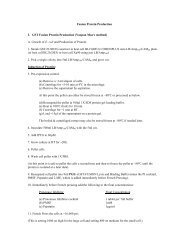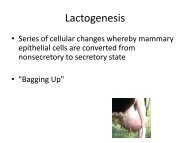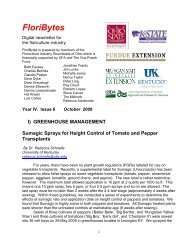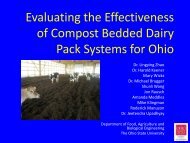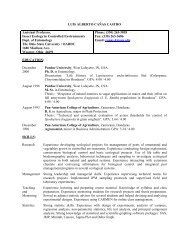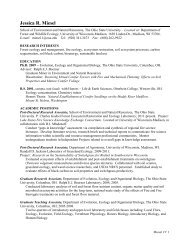Shrimp Alkaline Phosphatase Product Information Sheet 9PIM820
Shrimp Alkaline Phosphatase Product Information Sheet 9PIM820
Shrimp Alkaline Phosphatase Product Information Sheet 9PIM820
You also want an ePaper? Increase the reach of your titles
YUMPU automatically turns print PDFs into web optimized ePapers that Google loves.
<strong>Product</strong> Contents<br />
<strong>Shrimp</strong> <strong>Alkaline</strong> <strong>Phosphatase</strong> (SAP), Blue/White Cloning Qualified:<br />
Part No. Conc. (u/µl) Size (units)<br />
M820A 1 500<br />
M820B 1 20<br />
Description: <strong>Shrimp</strong> <strong>Alkaline</strong> <strong>Phosphatase</strong> (SAP) catalyzes the dephosphorylation of 5´ phosphates from DNA. Unlike<br />
Calf Intestinal <strong>Alkaline</strong> <strong>Phosphatase</strong>, SAP is completely and irreversibly inactivated by heating at 65°C for 15 minutes.<br />
<strong>Alkaline</strong> phosphatases are used to prevent recircularization and religation of linearized cloning vehicle DNA by removing<br />
phosphate groups from both 5´-termini and may also be used for the dephosphorylation of 5´ phosphorylated ends of DNA<br />
for subsequent labeling with [ 32P]ATP and T4 Polynucleotide Kinase. SAP is active on 5´ overhangs, 5´ recessed and blunt<br />
ends (1).<br />
Enzyme Storage Buffer: <strong>Shrimp</strong> <strong>Alkaline</strong> <strong>Phosphatase</strong> (SAP) is supplied in 25mM Tris-HCl (pH 7.6 at 4°C), 1mM MgCl2, 0.1mM ZnCl2 and 50% glycerol.<br />
<strong>Shrimp</strong> <strong>Alkaline</strong> <strong>Phosphatase</strong> 10X Reaction Buffer (M821A): When the 10X Reaction Buffer supplied with this enzyme<br />
is diluted 1:10, it has a composition of 50mM Tris-HCl (pH 9.0 at 37°C) and 10mM MgCl2 .<br />
Source: <strong>Shrimp</strong> (Pandalus borealis).<br />
Unit Definition: One unit is defined as the amount of enzyme required to catalyze the hydrolysis of 1µmol of 4-nitrophenyl<br />
phosphate per minute at 37°C in 1M diethanolamine, 10.9mM 4-nitrophenyl phosphate, 0.5mM MgCl2 (pH 9.8). See the unit<br />
concentration on the <strong>Product</strong> <strong>Information</strong> Label.<br />
Storage Temperature: Store at –20°C. Avoid multiple freeze-thaw cycles. See the expiration date on the <strong>Product</strong> <strong>Information</strong><br />
Label.<br />
Quality Control Assays<br />
Contaminant Activity<br />
Endonuclease Assay: To test for endonuclease activity, 1µg of Type I supercoiled plasmid DNA is incubated with 5 units of<br />
<strong>Shrimp</strong> <strong>Alkaline</strong> <strong>Phosphatase</strong> in 1X Reaction Buffer for one hour at 37°C. Following incubation, the supercoiled DNA is visualized<br />
on an ethidium bromide-stained agarose gel to verify the absence of visible nicking or cutting.<br />
DNase and RNase Assay: To test for nuclease activity, 50ng of radiolabeled DNA or radiolabeled RNA is incubated with<br />
5 units of <strong>Shrimp</strong> <strong>Alkaline</strong> <strong>Phosphatase</strong> in 1X Reaction Buffer for one hour at 37°C, and the release of radiolabeled nucleotides is<br />
monitored by scintillation counting of TCA-soluble material. Minimum passing specification is ≤3% release for DNase and ≤3%<br />
release for RNase.<br />
Blue/White Assay: The pGEM ® -3Zf(+) Vector (a) is digested with representative restriction enzymes (leaving 5´-termini,<br />
3´-termini or blunt ends). Ten micrograms of each cut vector are treated with 20 units of <strong>Shrimp</strong> <strong>Alkaline</strong> <strong>Phosphatase</strong> for 1 hour<br />
at 37°C, kinased and ligated. The religated plasmid is then transformed into JM109 cells, which are plated on X-Gal/IPTG/Amp<br />
plates. A minimum of 200–400 colonies are counted. White colonies result from transformation of ligated plasmids with damaged<br />
ends. These white colonies represent the number of false positives expected in a typical cloning experiment. Enzymes that<br />
generate overhangs, Hind III or Kpn I, must produce fewer than 2% white colonies, and the blunt-cutting enzyme, Hinc II, must<br />
produce fewer than 5% white colonies (2). Transformation efficiency of the cut, dephosphorylated, kinased and ligated vector<br />
must be ≥1 × 105 cfu/µg DNA.<br />
References<br />
1. Sambrook, J., Fritsch, E.F. and Maniatis, T. (1989) Molecular Cloning: A Laboratory Manual, Cold Spring Harbor<br />
Laboratory Press, Cold Spring Harbor, New York.<br />
2. Hung, L. et al. (1991) A blue/white cloning assay for quality control of DNA restriction and modifying enzymes. Promega<br />
Notes 33, 12–13.<br />
Part# <strong>9PIM820</strong><br />
Revised 12/04<br />
AF9PI M820 1204M820<br />
Promega Corporation<br />
2800 Woods Hollow Road<br />
Madison, WI 53711-5399 USA<br />
Telephone 608-274-4330<br />
Toll Free 800-356-9526<br />
Fax 608-277-2516<br />
Internet www.promega.com<br />
PRODUCT USE LIMITATIONS, WARRANTY, DISCLAIMER<br />
Promega manufactures products for a number of<br />
intended uses. Please refer to the product label for the<br />
intended use statements for specific products.<br />
Promega products contain chemicals which may be<br />
harmful if misused. Due care should be exercised with<br />
all Promega products to prevent direct human contact.<br />
Each Promega product is shipped with documentation<br />
stating specifications and other technical information.<br />
Promega products are warranted to meet or exceed the<br />
stated specifications. Promega's sole obligation and the<br />
customer's sole remedy is limited to replacement of<br />
products free of charge in the event products fail to perform<br />
as warranted. Promega makes no other warranty<br />
of any kind whatsoever, and SPECIFICALLY DIS-<br />
CLAIMS AND EXCLUDES ALL OTHER WARRANTIES<br />
OF ANY KIND OR NATURE WHATSOEVER, DIRECTLY<br />
OR INDIRECTLY, EXPRESS OR IMPLIED, INCLUDING,<br />
WITHOUT LIMITATION, AS TO THE SUITABILITY, PRO-<br />
DUCTIVITY, DURABILITY, FITNESS FOR A PARTICU-<br />
LAR PURPOSE OR USE, MERCHANTABILITY, CONDI-<br />
TION, OR ANY OTHER MATTER WITH RESPECT TO<br />
PROMEGA PRODUCTS. In no event shall Promega be<br />
liable for claims for any other damages, whether direct,<br />
incidental, foreseeable, consequential, or special<br />
(including but not limited to loss of use, revenue or<br />
profit), whether based upon warranty, contract, tort<br />
(including negligence) or strict liability arising in connection<br />
with the sale or the failure of Promega products<br />
to perform in accordance with the stated specifications.<br />
© 2000–2004 Promega Corporation. All Rights<br />
Reserved.<br />
(a) U.S. Pat. No. 4,766,072.<br />
(b) U.S. Pat. Nos. 5,658,548 and 5,808,041, Australian<br />
Pat. No. 689815 and other patents pending.<br />
pGEM and Wizard are trademarks of Promega<br />
Corporation and are registered with the U.S. Patent<br />
and Trademark Office. MULTICORE is a trademark of<br />
Promega Corporation.<br />
All specifications are subject to change without prior<br />
notice.<br />
<strong>Product</strong> claims are subject to change. Please contact<br />
Promega Technical Services or access the Promega<br />
online catalog for the most up-to-date information on<br />
Promega products.<br />
Part# <strong>9PIM820</strong><br />
Printed in USA. Revised 12/04
I. Reaction Conditions<br />
A. Standard Dephosphorylation and Ligation Reaction<br />
1. Incubate SAP (1 unit/µg DNA) with restriction-digested vector (restriction enzyme<br />
and buffer removed, DNA in water or TE buffer) at 37°C for 15 minutes in 1X SAP<br />
reaction buffer in a final volume of 30–50µl. This is a sufficient amount of SAP to<br />
completely dephosphorylate the vector regardless of overhang type (5´, 3´, or blunt).<br />
2. Inactivate SAP by heating to 65°C for 15 minutes.<br />
3. Centrifuge the reaction mix. Remove a 1–2µl aliquot for ligation with appropriate<br />
DNA insert in 1X ligation buffer at 4°C overnight for all types of DNA overhangs.<br />
Final volume should be between 10–50µl. Molar ratios for vector to insert can range<br />
between 1:8 to 8:1. A 1:1 ratio is recommended as a starting point.<br />
4. Transform the ligated material directly into competent E. coli cells.<br />
B. Streamlined Restriction Digestion, Dephosphorylation<br />
and Ligation Procedure<br />
1. Combine restriction digestion and dephosphorylation of DNA vector in 1X restriction<br />
enzyme buffer. Use 15 units of restriction enzyme/µg vector and 10 units SAP/µg<br />
vector in a final volume of 30–50µl. Incubate at 37°C for 15 minutes. This is a<br />
sufficient amount of SAP to completely dephosphorylate the vector regardless of<br />
overhang type (5´, 3´, or blunt).<br />
2. Heat-inactivate both restriction enzyme and SAP for 15 minutes at 65°C.<br />
Note: Not all restriction enzymes can be heat inactivated.<br />
3. Centrifuge and remove 1–2µl (~40ng) of vector for ligation with appropriate DNA<br />
insert using 2X Rapid Ligation Buffer (Cat.# C6711) and 2µl (6 units) of T4 DNA<br />
Ligase (Cat.# M1801) at 15°C for 5 minutes (3´ or 5´ ends) or 15 minutes for blunt<br />
ends in a final reaction volume of 10–50µl. We recommend starting with a 1:2 molar<br />
ratio of vector:insert DNA.<br />
4. Transform the ligated material directly into competent E. coli cells.<br />
C. Standard Dephosphorylation and Labeling Reaction Using T4<br />
Polynucleotide Kinase<br />
1. Incubate SAP (1 unit/0.5pmol ends) and DNA at 37°C for 15 minutes in 1X SAP<br />
buffer in a final volume of 30–100µl.<br />
2. Purify the DNA using the Wizard ® DNA Clean-Up System (b) (Cat.# A7280).<br />
3. Labeling is carried out by incubating 8–10 units T4 Polynucleotide Kinase (M4101),<br />
≤10pmol DNA ends and 15µl [γ 32P] ATP (3,000Ci/mmol, 10mCi/ml) at 37°C for<br />
10 minutes in 1X PNK buffer and a final volume of 50µl.<br />
II. Composition of Buffers and Solutions<br />
2X Rapid Ligation Buffer<br />
60mM Tris-HCl (pH 7.8 at 25°C)<br />
20mM MgCl 2<br />
2mM ATP<br />
10% PEG<br />
20mM DTT<br />
III. Related <strong>Product</strong>s<br />
<strong>Product</strong> Size Cat.#<br />
Wizard ® DNA Clean-Up System 100 preps A7280<br />
T4 Polynucleotide Kinase 100u M4101<br />
2X Rapid Ligation Buffer 3 × 500µl C6711<br />
T4 DNA Ligase 1,000u M1801<br />
Usage <strong>Information</strong><br />
Table 1. Activity of <strong>Shrimp</strong> <strong>Alkaline</strong> <strong>Phosphatase</strong> (Part# M820A) in<br />
Restriction Enzyme Buffers vs. 1X <strong>Shrimp</strong> <strong>Alkaline</strong> <strong>Phosphatase</strong><br />
Buffer.<br />
Promega Restriction % Activity<br />
Enzyme Buffer of SAP<br />
A 20<br />
B 20<br />
C 25<br />
D 35<br />
E 20<br />
F 60<br />
G 30<br />
H 30<br />
J 25<br />
K 20<br />
L 30<br />
MULTI-CORE 10<br />
Part# <strong>9PIM820</strong><br />
Printed in USA. Revised 12/04<br />
Promega Corporation · 2800 Woods Hollow Road·Madison, WI 53711-5399 U.S.A. · Toll Free in the USA 800-356-9526 · Telephone 608-274-4330 · Internet www.promega.com



